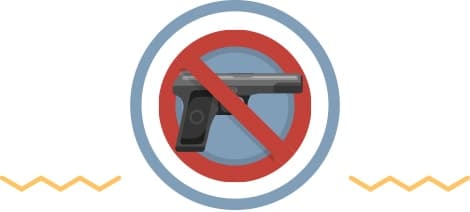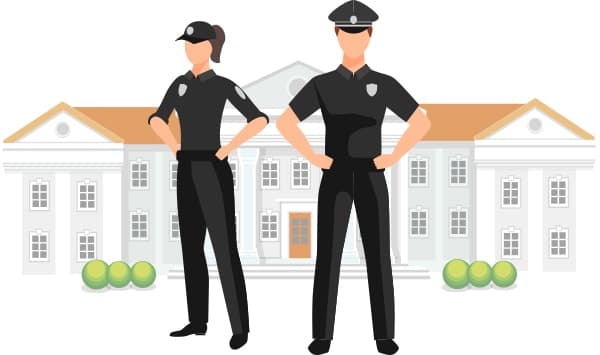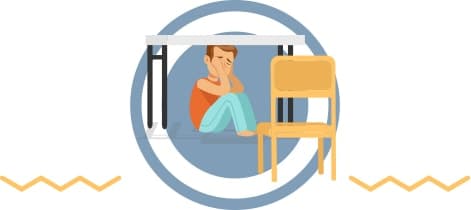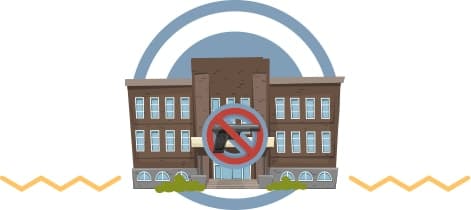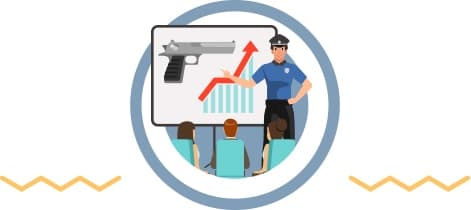Practical Steps for Schools and Hometowns to Address Gun Threats and Violence
Gun violence is a serious issue in many areas of United States society. Virtually anyone anywhere can be victimized, including a toddler at home, a five-year-old in school, an adult picking up snacks at the neighborhood convenience store and the teen down the road who struggles with depression or mental health issues. It manifests itself through suicides, accidental shootings, gang shootings, domestic violence killings, mass shootings and much more. Schools and hometowns owe it to their students and residents to develop strong measures for gun violence prevention and protection. The guide that follows serves as a starting point.
View from the Experts: School Gun Violence and Threats
Prevention and Protection in Schools
Looking at a timeline of school shootings since Columbine is an eye-opening experience. The sheer number of school shootings that happen on an annual basis is enough to scare any parent. To help address these issues, the Department of Homeland Security created a guide that touches on multiple prevention and protection strategies. They boil down these steps to: Connect, plan, train and report.
- Connect early with local law enforcement and other first responders in the community surrounding the school.
- Establish a plan (or form a team responsible for planning) for active shooter situations and other types of gun violence.
- Train employees, students and others connected to the school in these plans and in how to respond. Conduct training on an ongoing basis so everyone is comfortable and aware of what to do.
- Last but not least, put something in place to report suspicious activity, such as a tip line. Connect with law enforcement about setting one up.
Getting Started with Identifying Vulnerabilities
School employees, whether it’s a teacher or a principal, rarely have any in-depth security training. Finding vulnerabilities just isn’t in their wheelhouse. But, they still want to create a safe environment for the students they teach.
To help school staff create a safer environment, the DHS created the K-12 School Security Survey (2018) which acts as a questionnaire schools can use to find their vulnerabilities. Here’s a brief overview of the vulnerabilities that the survey covers:
- The school and district have security managers
- The school has security forces and if so, whether security personnel have equipment such as communications devices, panic alarms and weapons
- The school has a threat assessment team
- Exterior doors are locked during school hours
- Teachers, staffers and students know the emergency plan and are trained to respond in emergency situations
- There are vehicle search procedures
- The school has mass notification
- The distance between the school and a vehicle in the parking lot is safe
- There is coordination with first responders in regard to preparation
- The construction of exterior doors could slow or stop an invader
- The school has fences, and if so, their height and material
- A shooter could hide in low-visibility areas in stairways, hallways and common spaces
- A camera surveillance system exists
Taking this survey gives school staff and safety officials a clear path toward creating a safer school environment. You’ll know your school’s strengths and weaknesses, and answering the survey gives you action items to pursue.
Each School Is Unique
It’s important to remember that each school (and each hometown) is unique. For example, security measures that a school in Los Angeles might want to take may not be a good idea for a school in rural Wisconsin. Even two Los Angeles high schools are likely to have different threat levels, needs and considerations. Things that can significantly change a school’s safety plan include:
- How modern the building is (historic buildings might need retrofitting)
- Financial resources
- Crime levels in the neighborhood and what types of crime
- Number of students with disabilities and which disabilities
- Number of non-English-speaking students and visitors
Look at your school and its strengths, weaknesses and needs to assess where the highest and likeliest risks are and to develop preventive and security measures. Don’t skip this step! If you merely follow what another school or district did, you could miss many valuable opportunities.
In general, the steps to take include the following:
- Do the School Security Survey and note the action items to take
- Foster a positive school climate
- Select someone to act as school safety and security manager if there isn’t one already
- Form an anti-gun violence safety team and a threat assessment team
- Establish an effective tip reporting structure (hotline, smartphone app, text messages, website)
- Implement clear and strong policies against bullying, drug use and other items touched on below
- Run different types of drills regularly, and evaluate how they can be improved upon
What Is Prevention?
Preventing gun threats and violence can take many forms. Here are just a few examples:
- A hotline that takes tips of gun threats seriously
- Early identification of potential mental health problems and quality access to mental health services
- Awareness of warning signs such as an individual’s suddenly erratic behavior or increasing isolation
- Strong anti- bullying, anti-cyberbullying and anti-harassment policies
- Regulations against weapons, drug and alcohol possession/use
- Resource police officers based at the school
In addition, some schools use measures such as metal detectors and transparent backpacks. There’s no right or wrong answer as to whether such measures could help your hometown or your school. There will always be conflicts among the various interests at stake. What’s important is that the team tasked with preventing gun violence at your school carefully weighs the advantages and disadvantages of these measures and makes an educated decision.
One thing that can happen is a false sense of security. For example, say that a certain high school decides to install metal detectors at all entrances. With this approach in place, school officials may think they’ve solved the problem of gun violence and don’t need to worry about other gun safety measures. Not true. The school may actually be less safe with the metal detectors than if it had instituted a comprehensive, wide-ranging safety plan. After all, there are many ways to work around metal detectors—passing a gun through a window, for instance, or doing the violence outside the school building.
The Gun Violence Safety Team
Who should be on the team that works to put prevention and protection measures in place? Here’s an example of what such a team at one school might look like.
- Safety and security manager for the school district
- School counselor
- Safety and security manager for the school
- Threat assessment team (TAT)
- Principal and other administrators
- Social media monitoring team
- School resource officer (police officer based at the school)
- Teachers, staffers, students and parents
Safety and security manager for the school district: Most school districts, if not all, have this type of manager in some form. These managers can be responsible for multiple things as they oversee safety and security at each school in the district. They develop and coordinate training and emergency response programs and respond to emergencies and crises any hour of the day. The managers liaise between the school district and law enforcement, emergency responders, public safety communications officers and others. For individual schools, the managers supervise each school’s crisis management and emergency response teams and oversee the creation of a safety plan. They also develop the school’s drill calendar and conduct unannounced drills such as a violent intruder drill.
Safety and security manager for the school: In an ideal situation, the district’s safety and security manager would coordinate closely with the school’s safety and security manager. Of course, it’s possible your school doesn’t have a safety and security manager. Each school should have one, and multiple risk factors determine if the position should be the person’s devoted job or just one task among many that he or she does. For instance, a school in a tiny district with a low risk level could possibly have the principal or counselor do the job.
To start small, a school could designate an employee to act as safety and security manager. This person works with others to develop, implement and coordinate all activities related to reducing gun violence and threats affecting the school.
The manager must ensure that the school has an up-to-date gun violence plan that addresses risk assessment, physical security, drills, communications, evacuation, lockdown, hazard analysis and specialized responses for areas such as the cafeteria, gym, library and portable classrooms, and other areas. The manager also ensures that everyone involved with the school is aware of the plan and has been adequately trained to follow it.
Principal and other administrators: Whether or not the principal or other administrators act as the school’s safety and security manager, their buy-in is critical. They should be looped into ongoing anti-gun violence safety processes and have the opportunity to provide input.
School resource officer: A school resource officer is a police officer usually based at a high school, although some middle and elementary schools have resource officers too. These officers should be trained in how to respond to gun violence threats and to active shooter situations. They may not always be able to stop school shootings, but if your school has a resource officer, this person absolutely needs to participate in the anti-gun violence safety effort.
If your school doesn’t have an officer, consider reaching out to the police department about bringing one on board. In many cases, the officers help to reduce overall gun violence at the school and the rates of property damage. They can also foster a more positive school climate.
School counselor: Like school resource officers and principals, school counselors can wear many hats: leader, facilitator and confidante, to name just a few. However, it may be school counselors who, more than anyone else, have the official responsibility of ensuring that each student has at least one positive connection to the school, whether it’s with the custodian or one of the paraeducators. This one positive connection means a trusted adult for a student to reach out to in cases of potential gun violence. For instance, say that a student suspects his friend will bring a gun to school. He should have someone he trusts at the school to reach out to.
Counselors must be visible and accessible and help schools create an atmosphere of trust so that students feel empowered to report suspicious behavior and to seek help for themselves and others. Counselors can be in a unique position to reduce gun violence in schools and to identify at-risk youth such as those who are isolated or who have behavioral issues.
Pertaining to gun violence safety, counselors can:
- Coordinate and implement trainings on topics such as de-escalation and early warning signs that a student might turn violent
- Reach out to parents
- Work with the resource officer
- Conduct threat assessments to evaluate the odds that a student might follow through on a threat, become violent again or repeat a certain behavior
- Help students recover and heal from a crisis or shooting
Threat assessment team (TAT) and social media monitoring team: The job of a TAT is to look into behaviors and communications to determine if someone such as a student, former student, parent, school employee or former employee could be a threat to others or to the individual. A social media monitoring team tends to watch out for problematic issues on social media such as bullying, drastic personality changes or threats of violence. Both teams need to keep the law and students’ rights in mind as they operate. They may have a few overlapping members but should be different enough to avoid tunnel vision or burnout.
Potential TAT members include counselors, law enforcement and outside professionals such as other law enforcement officers, counselors and medical personnel. They should receive ongoing, extensive training and have a documented threat assessment process
As for a social media monitoring team, what could be an intensive, labor-heavy effort is made easier by algorithms and keyword alerts that notify the relevant personnel if a certain phrase or word is used. It’s possible for one person such as an IT guru at the school to set this up or for the school to consult with an outside company to handle it. Personnel such as principals, teachers or counselors can be tasked with reviewing the alerts that come in and deciding which ones to take to the administration, counselors or TAT.
Teachers, staffers, students and parents: Which school security measures are working? Where is the school falling short? Do students and teachers feel safe? Is the school climate positive?
Teachers, staffers, students and parents are vital parts of anti-gun violence safety endeavors at any school. It is often students who report threats to personnel at the school or who call them in to tip lines. Parents, too, may report a child’s friend who brought a gun to school or their own child.
Populations with Disabilities and Other Needs
The United States is a diverse society in which many people don’t speak English fluently or at all. Many people also have disabilities such as blindness or hearing impairment. Remember to keep all these different groups in mind when developing various safety procedures. In fact, the best way to ensure access and inclusion is to involve some of these people in safety planning, training and execution.
Tip Hotlines
Your school should have an anonymous tip hotline (ideally via phone, text, website and smartphone app) where students, teachers and others in the community can report gun threats and other safety threats. This solution is fairly inexpensive to implement, and many times, the hotlines are coordinated at the state or school district level. In these cases, an individual school’s main responsibility may mainly be to market and publicize the existence of the hotline and to educate students on how to use it.
However, not all responses to tip hotlines are created equally, and some tips do fall through the cracks. For example, local law enforcement may not always respond to potential threats after being tipped off. Since most school shooters let at least one person know about their plans, it’s critical to have as tight a hotline and response as possible. Colorado’s Safe2Tell is a model to follow, and in 2017-2018, it received 692 tips about potential attacks. In comparison, it got 2,786 tips about suicide, 1,831 about drug use and 1,641 focusing on bullying. Whatever the content of a tip, having this hotline option can make students feel safer and like they are being heard.
Safety Drills
Drills serve many purposes. For instance, they can help students feel more in control if an actual threat occurs and increase the chances that everyone responds as they should. They are also a way to test readiness—do teachers, including substitute teachers, have all of the codes, remotes and keys they require to lock doors?
It’s important to hold each drill at different times and on different days because students and others move around as the day progresses. Your school can also hold drills every once in a while with first responders. However, look for a balance when conducting active shooter drills, lockdown drills and other types of drills. Some drills end up traumatizing students needlessly.
The work of a drill is not finished after the drill itself is complete. After-action reports and improvement plans can make future drills more useful and better protect those at the school if gun violence occurs. Here’s an example of a guide from the Readiness and Emergency Management for Schools Technical Assistance Center. It covers what to do before, during and after drills.
Post-drill evaluations are important. These include debriefing sessions with students, teachers, and others. It’s vital to discuss how the drill went – what was done well and what could have been done better. From there, an improvement plan can be set up, which should touch on specific actions, designate certain teams or people on these actions, and a clear timeline of completion. Practice makes perfect, but only when there’s commitment to improve.
Your School Climate
The type of school climate can make a big difference in the number of threats that students report and in how often they bring weapons to school. For instance, take a school in which the counselors are proactive about fostering strong connections between students and at least one adult at the school. The school’s policies are clear and fairly enforced. Information about tip hotlines to report safety threats is visibly posted every day and is repeated after drills. Personnel encourage parents to engage in their students’ education.
Now take a school in which counselors just go through the motions until they can leave for the day. Policies such as those on cyberbullying and weapons at school are unclear, frequently ignored or disproportionately enacted depending on a student’s race, family background, perceived “good kid” or “bad kid” status and so on. There isn’t much marketing done about tip lines. At this school, students and others may be more hesitant to speak up about potential safety issues because the lines of communication aren’t there. Plus, they may fear punishment for themselves or others if they tell someone that another student might bring a gun to school.
The National School Climate Center lays out 13 dimensions such as sense of physical security, social media and respect for diversity that factor into school climate. The center offers the Comprehensive School Climate Inventory to help you measure the climate at your school and get guidance on areas for improvement.
Should Your School Arm Teachers?
Your school or district may experience controversy over whether it’s a good idea to arm teachers and staffers. The National Association of School Resource Officers recommends against it for these main reasons:
- Teachers and staffers may not be prepared to take a student’s life or another person’s life whereas a police officer has been trained for such an occasion
- Teachers and staffers might not keep up the extensive ongoing training required to maintain a high level of firearms skills
- It is very difficult to fire well and accurately in a high-pressure situation
- Teachers and staffers could be mistaken for the shooter by police arriving on the scene
- Teachers and staffers might not keep a gun 100 percent secure, opening up the risk of accidental discharge, either by themselves or others
- Teachers and staffers could be overpowered and their firearm taken away by a shooter
- Teachers and staffers might accidentally shoot or kill others during a crisis
- Teachers and staffers might not be able to accurately assess the risks of firing versus not firing
Rather than arm teachers and other personnel, your school might want to consider bringing more well-trained resource officers on board. However, teachers in some states and school districts can and do carry firearms. The bottom line is that your school needs to be aware of the relevant laws and school district regulations when crafting safety policies.
How Hometowns Can Keep Citizens and Students Safe from Gun Violence
Gun violence in and around schools is just one part of the picture. For example, the DHS analysis of 250 active shooter incidents from 2000 to 2017 showed that 20.8 percent occurred in an educational setting. Forty-two percent occurred in malls and businesses, and 14 percent occurred in open spaces. Ten percent took place in government settings. Residences, houses of worship, health care facilities and other locations made up the rest.
Active shooter situations aside, many types of hometowns grapple with multiple issues related to gun violence. The violence could be related to suicides, gangs or unsecured guns that toddlers and children could access—the list goes on.
Federal and state laws often restrict what hometowns are allowed to do. In forty-three states, towns can’t implement regulations that impose stricter gun rules than what the state has. There may be loopholes every once in a while such as those with bump stocks, but they are the definite exception to the rule. Federal laws do allow hometowns to take steps such as enacting gun-free school zones, which can cut down on the number of drug dealers, gang members and would-be shooters around schools. In urban areas, such moves can be extremely helpful.
>> Read More: GUN COUNTRY: Where in the U.S. Are Guns Most Popular?
The Risk of Suicide with a Firearm
Mass shootings may get most of the attention, but the potential for suicide is a huge concern. In fact, two-thirds of all gun deaths are suicides, and half of all suicides are committed via firearm. The most sobering statistic may be this: The risk of suicide goes up by three times when someone has access to a firearm, whether it is a personal firearm or one in the household. Even when variables such as mental illness, poverty and unemployment are accounted for, the risk still remains. Hometowns in states where there are high levels of gun ownership tend to see relatively elevated levels of suicides.
Jumping into Action
So what can hometowns do to address gun violence? To give a sampling, they can:
- Emphasize measures for responsible firearm storage at home
- Boost general awareness that firearms increase suicide risk
- Develop plans to temporarily take away firearms from people who are suicidal or otherwise in a moment of crisis
- Install tip lines where citizens can report fears that someone will harm themselves or others
- Have police officers and others in authority better engage the public and earn their trust
- Coordinate with schools, businesses and government agencies on gun safety plans and response measures
- Sponsor student contests to reduce gun violence (essay contests on gun safety, for example)
- Host gun buyback programs
- Clamp down on police officers behaving illegally
- Have gun safety classes
- Expand access to counseling and other mental health services
- Encourage doctors to speak up
To expand on the last point, many doctors like to discuss firearm safety with their patients and their patients’ families. Some versions of this aren’t allowed in Montana, Missouri and Minnesota, but the involvement of doctors can be critical. For instance, a doctor in Philadelphia, a city where many citizens are exposed to firearms, might want to ask new parents about firearms in the home to help them better secure the weapons. Patients who have mental illness and suicidal thoughts can also be well-served by having open, honest communications with doctors about guns.
Research and Address
Officials should research gun violence in the hometown and address the points that the research provokes. For instance, were there more gun-related incidents around a certain school or in a certain neighborhood? Why? What resources can the town devote to that area? Similarly, are there relatively high numbers of accidental gun deaths lately? Why? Perhaps parents need to be educated more on securing their guns away from their children.
Many hometowns benefit from this type of research. For example, Chicago analyzes the underground gun market and data from guns used in crimes to find solutions to gun crime. Milwaukee criminal justice and public health officials study data derived from every shooting and homicide in the city to analyze the drivers behind gun violence in the city.
The research your hometown does may point to these solutions:
- Offering alternative programs and activities for at-risk youth and adults
- Improving lighting at night
- Transforming public spaces so guns are harder to hide in vacant lots and public places
- Sponsoring programs with hospitals, street workers and law enforcement where professionals learn about methods such as de-escalation and can pass them on to at-risk community members
- Improving how gun crimes are investigated and tried to ensure that police and other authorities don’t doom a case by not following correct procedures
- Enforcing restrictions such as not allowing convicted domestic abusers to have access to guns
- Promoting responsible gun storage in vehicles (to reduce the number of guns stolen from cars)
- Developing a Crime Gun Information Center or something similar
- Reaching out to lawful gun owners
- Mapping crimes
- Tracing the path of a gun
- Leasing property only to those gun shows where gun vendors agree to run background checks for each sale
- Requiring alcohol blood or breath tests for people who may have negligently fired a gun
- Requiring a background check for all gun sales
- Clamping down on any retail gun stores or dealers connected to disproportionate amounts of gun violence
- Encouraging gun owners to report lost or stolen firearms
- Offering free gun locks
- Using acoustic detection to quickly pinpoint where guns are being fired
- Following up with would-be gun purchasers who failed a background check
- Implementing focused deterrence programs targeted toward repeat offenders and neighborhoods
- Helping gunshot victims with addiction treatment, conflict-resolution treatment and other approaches
Just like each school is unique, each hometown is unique. What works well for one town might be a waste of time for another. So, it really is important to assess gun threats and violence in your specific town and to look for patterns and to tailor solutions to your town.
Many Issues to Think About
Hometowns are where children live, go to school, learn, play, make friends and become better-rounded people. At school, children also participate in fire drills, and depending on the area of the country, drills to protect themselves from hurricanes, tornadoes and earthquakes.
In the 1950s and 1960s, many schoolchildren participated in “Duck and Cover drills” in the face of threats such as those posed by the Cuban Missile Crisis. Now, schoolchildren take part in active shooter drills and other drills centered on gun violence and threats. Lockdowns can be frequent, especially at schools in neighborhoods where domestic disputes and gun violence are common.
Hometowns and schools have a lot to think about when it comes to gun violence and threats. Mass shootings tend to grab the headlines, but students and community members may have guns if they’re suicidal, mentally ill, trying to protect themselves against bullies or gangs or are in gangs themselves. Schools and hometowns must consider more than mass shootings when evaluating gun violence and threats.
Additional Resources
- Responding to School Violence: Tips for Administrators
- Why Schools Need Two Types of Lockdowns
- Strategies for Reducing Gun Violence in American Cities
- Active Shooter: How to Respond
- Active Shooter Preparedness
- Crime Prevention Through Environmental Design (CPTED) School Assessment (CSA)
- Guide for Developing High-Quality School Emergency Operations Plans
- Making Prevention a Reality: Identifying, Assessing, and Managing the Threat of
- Targeted Attacks
- The K-12 School Shooting Statistics Everyone Should Know
- Gun Violence Must Stop.




